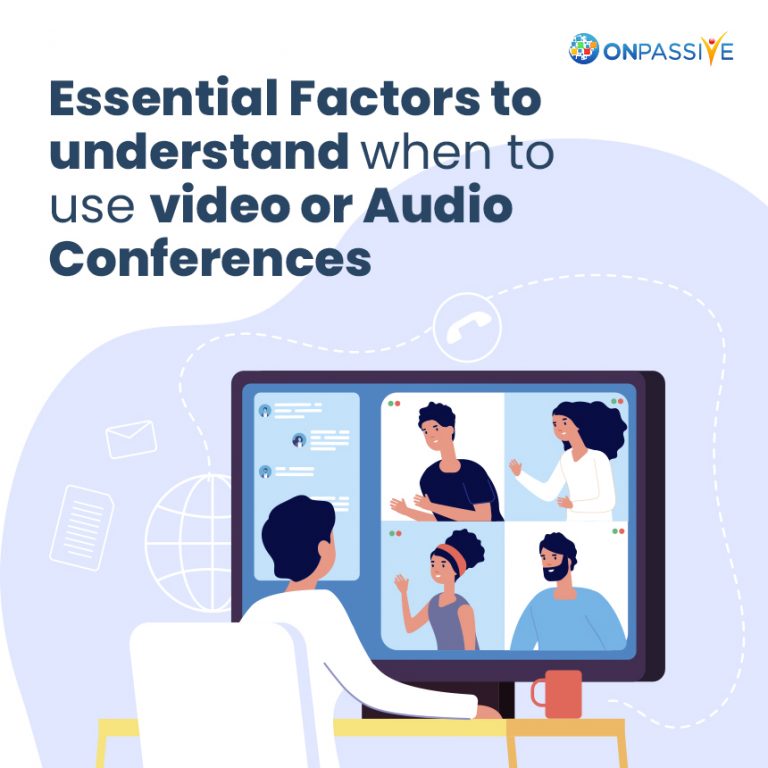
The pandemic situation has led many businesses to rethink the ways to operate since the last year. Although there are few signs of returning to normality, remote working is still being followed by the maximum number of companies making the employees’ safety a priority.
Even in remote working conditions, staying in touch with each other is very important for business operations to coordinate with team members, taking care of team morale, and improve the efficiency of the business functions.
With physical meetings being out of action due to remote working conditions, many organizations worldwide are opting for remote collaborations. However, deciding on the meeting format can be tricky because the working conditions can alter for each employee.
Two primary modes are being used currently by many organizations to conduct the conference and communicate with the employees on critical business matters. They are through video and audio conferences. However, choosing one of these modes depending on the requirement can completely change the dynamics of the meeting.
Audio Conference
The audio conference, also known as teleconference, is a remote method of organizing a business conference or meeting. The participants use telephones and audio equipment to communicate with each other.
Audio conferencing can be very easy and manageable as it only requires a phone and is very economical and affordable. The great advantage of using an audio conference is that people can participate in the conference anytime and from anywhere irrespective of their surroundings since they are not visible.
Video Conference
As the name suggests, video conference refers to integrating video into the teleconference, transforming it into a different type of remote business conference. Also known as a virtual meeting, this conference method requires the participants to have internet, phones, or laptops with a camera, and access to various apps used for virtual meetings to be able to participate in the conference.
Virtual meetings allow businesses to have better communication with each other when remotely working as they can see each other. With the recent technology innovations, video conference allows participants to make presentations virtually using slides or photo galleries.
This helps participants gain more insights from the meeting and can be much more engaging than an audio conference with better connections and visuals.
Factors to understand when to use video and Audio Conferences
Both audio and video conferences can be fast and effective modes of communication. However, video conference requires internet and need little extra efforts. There might be few technical problems that require an operator from the conferencing service to handle. Therefore, choosing the suitable mode of the conference is crucial for businesses.
The following are few factors to be considered before choosing the proper mode:
- The Time Factor
Sometimes, there may be few occasions where businesses might need a quick catch-up. In such cases, audio conferencing comes handy and works well unless you need to quickly explain a complex idea to the participants through a digital whiteboard.
For many aspects of work processes, regular meetings are very essential. But using video conferencing for all the meetings may be costly and time-consuming. In such cases, audio meetings can be conducted as they are very quick and comfortable.
Therefore, considering the time factor is very important to decide if you want to have a video or audio conference. Businesses can calculate the duration of the meeting and, based on the requirement, can decide if they need a video or audio conference.
People these days are required to adapt to different ways of communication, and they need to interact with many people on a daily basis, including clients, customers, vendors or colleagues. However, technical hitches, poor connection or a lack of equipment can rule out the opportunity of the video conference.
Businesses need to consider each participant’s technical situation and check if they have all the required equipment for the video conference, and ensure each persons surrounding are as optimal as possible.
Therefore, businesses need to check the budget and invest in the best software or hardware that is required by the entire team for the best experience of everyone participating in the conference.
One of the significant advantages of video conferencing is the scope to share visuals. Visual conferences can be more engaging and interactive as visual aids combined with illustrations make the entire process of communication more better.
The combination of the digital workspace and virtual meeting can enhance the meeting experience. However, businesses need to consider if they need the visuals in the meeting, checking if all employees have the access and proper environment required for video conference.
The factors mentioned above helps businesses take the right decision while choosing between video and audio conferences for their organization.
Conclusion
Video and audio conferences have their own set of pros and cons. Therefore, businesses must choose the right medium for conferences that best suits the business needs. Businesses should properly analyze workers’ requirements and the workspace before choosing between video and audio conference method. Tools like OCONNECT by ONPASSIVE gives the leverage to the users to opt for high-quality audio and video conferencing. If you are a business then you need to identify the right match for your work and optimal utilization


